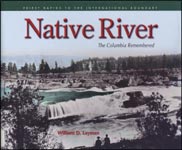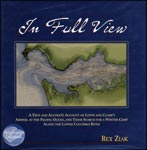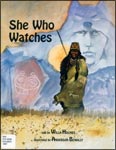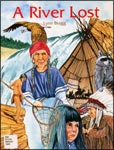Washington Reads (Fall 2004) - The Columbia River through Washington History
The Columbia River, in volume the largest river to flow into the Pacific Ocean, is woven into the lore and the history of Washington State. This powerful, untamed river was the source of livelihood, transportation, and folklore of the ancient cultures. With the development of dams and reservoirs, it became the great source of hydroelectric power and irrigation. With the taming of the original river came the dwindling of salmon runs, jobs, traditions, and towns. This wonderfully wild and natural river so significant in our state?s history was changed forever.
| Adult |
 |
Layman, William D. Native River: The Columbia Remembered
The author provides a wealth of information through his research into most aspects of the mid-Columbia River. The book features photographs, maps, and illustrations, many of which were unpublished. In addition, the book tells a story of the river, drawing the reader into its lore through the ancient tales, photographs, and petroglyphs. Layman hopes "that within these pages echoes of the Mid-Columbia's original music may yet be heard by imagining the sounds and rhythms of the rapids." Book cover courtesy of WSU Press, photo Frank Palmer, Kettle Falls Public Library. |
 |
Reyes, Lawney. White Grizzly Bear's Legacy: Learning to be Indian
Reyes, who is the grandson of White Grizzly Bear, tells the story of his family and his people. The tale gives us insight into the flooding of Kettle Falls, the forced displacement of natives, and the loss of his tribe's homeland and traditional ways of life. The blending of family and tribal history gives us a glimpse into the tragedy of the Sin Aikst tribe as well as into the rich lives eventually fashioned by Reyes and his brother, Native American leader Bernie Whitebear. |
 |
Ziak, Rex. In Full View
This is a compelling work about the Lewis and Clark expedition, describing the thirty days from November 7 to December 7, 1805; the book itself is a work of art. The narration follows the Corps passage through the lower Columbia, and conveys through the narrative, quotes from the journals, exquisite photographs and maps, the danger and excitement of the expedition during one month. It brings to life the sense of despair mixed with final triumph, wrapped in a graphics and remarkable photography. Ziak's background in photography and cinematography combine with a depth of research on the environment and history to create an exquisite book that is a "must read" for Washingtonians. Originally a winter 2004 "Washington Reads" selection when the theme was "Lewis, Clark, and Seaman", this marvelous book fits the Columbia River theme so well that it must be included again. |
| Young Adult |
 |
Homes, Willa. She Who Watches. Illustrated by Anderson Benally.
The ancient petroglyph known as "She Who Watches" is scratched into the rocks above the Columbia Gorge, watching over a very different scene than that of the ancient cultures. The Columbia River Tales, told by the Oldest of the Old Wishram people, are gently retold, woven with humor and the dignity of the natives along the Columbia. The illustrations are themselves works of art. |
| Children |
 |
Bragg, Lynn. A River Lost.
The story of an ancient culture along the Columbia that is changed forever by progress and modern technology gives our children a glimpse of how the construction of the Grand Coulee Dam touched the lives of the natives, destroying forever their way of life. Told by a child and her great-grandmother, it offers a glimpse of the disbelief by the elders of the Colville Confederated Tribes that man could turn their river into a great lake and destroy their access to salmon. |